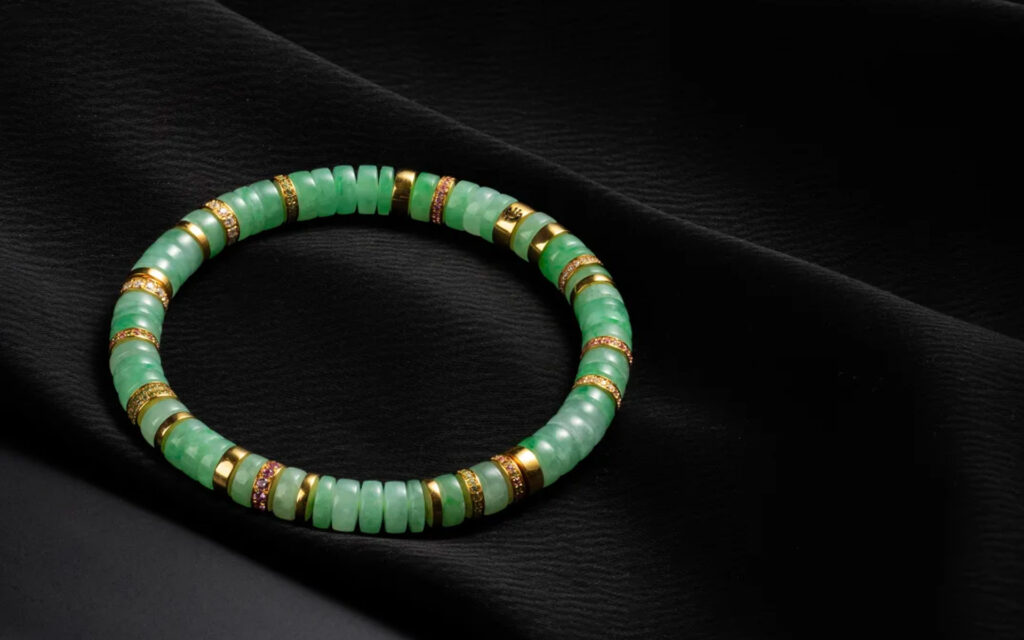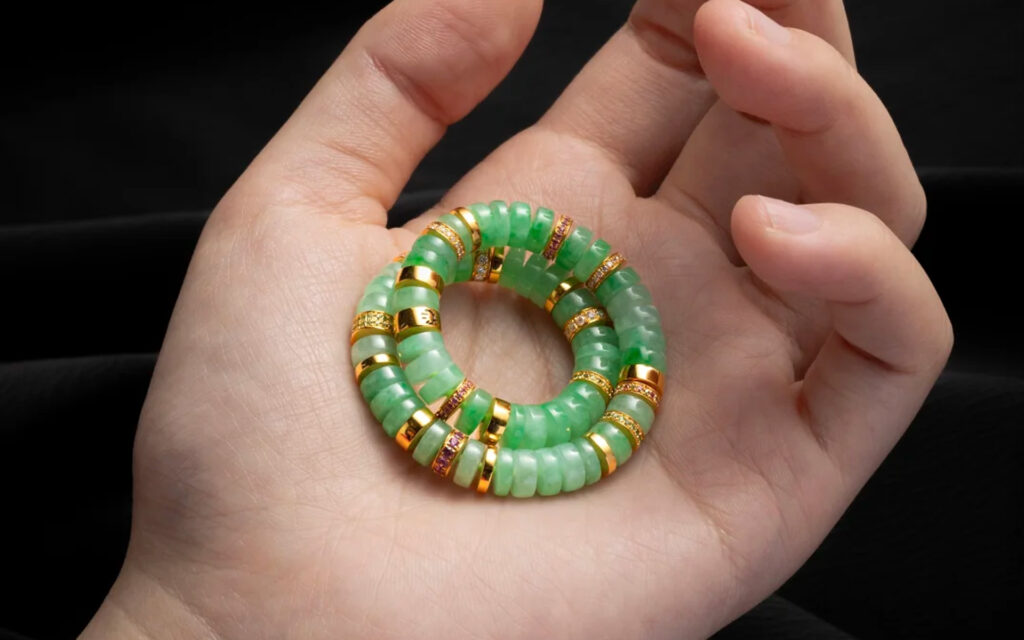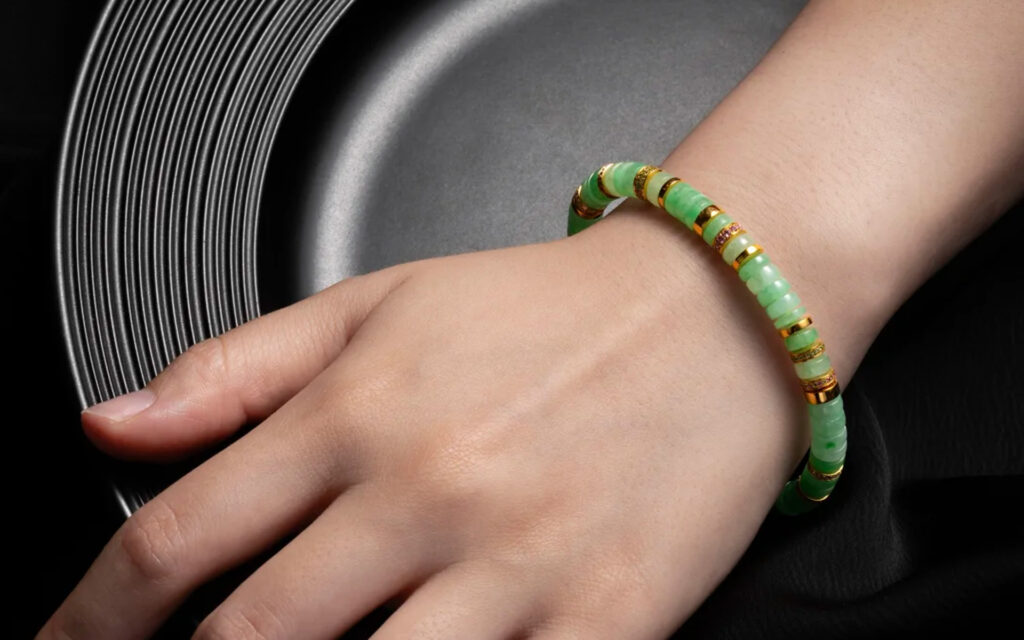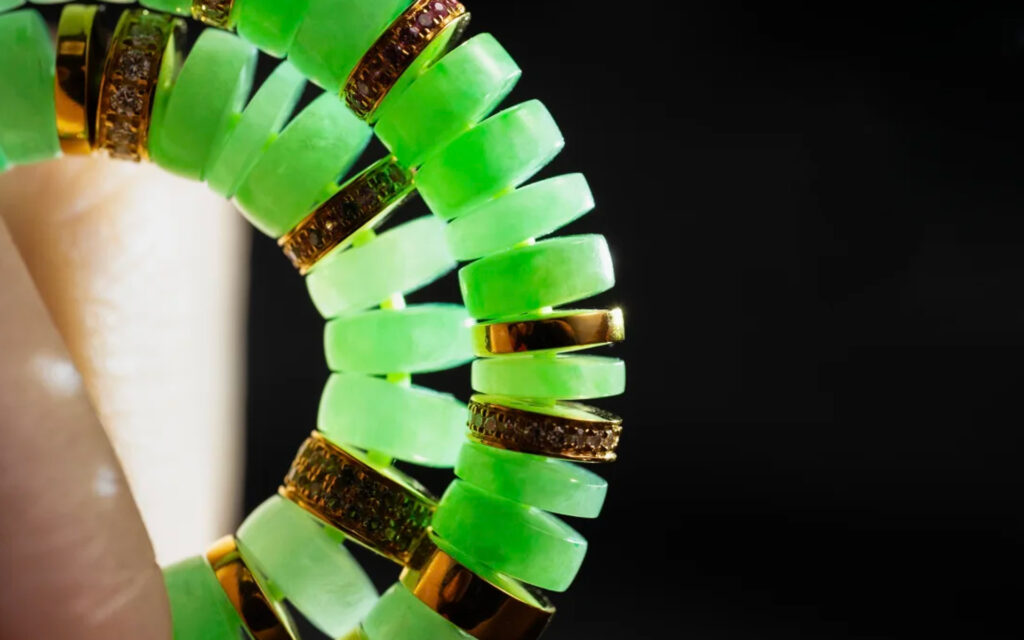Today, jadeite bracelets remain central to the 2025 jewelry market as emblems of Eastern jewelry culture. Their price spectrum—from imperial green pieces fetching hundreds of millions at high-end auctions to entry-level options priced at hundreds of dollars on e-commerce platforms—reflects the complexity of the jadeite market. Below, we delve into the pricing structure and consumption trends of jadeite bracelets through market data and industry insights.

I. Price Range: A “Pyramid” Structure from Hundreds to Millions
1. Entry-Level (¥100–¥1,000)
Market Characteristics: Primarily low-grade jadeite like dry green or iron dragon, or B+C grade treated with dyeing and acid washing.
Typical Products: “Natural jadeite bracelets” popular on e-commerce platforms are often dyed quartzite or imitations made from glass/resin.
Pricing Logic: Low production costs, but beware of counterfeit traps. For example, a wholesale platform lists 10mm red jadeite beads at just ¥2.9 each, with over 30 monthly sales—most likely artificially enhanced materials.
2. Mid-range (¥1,000–¥30,000)
Market Characteristics: Primarily glutinous-type and ice-glutinous jadeite, featuring pale green, cloud-like patterns, or colorless hues. Craftsmanship relies mainly on machine carving, with some pieces incorporating hand-polishing.
Representative Products:
Ice-like glutinous jadeite bracelet with cloud-like patterns: Market price in 2025 ranges from 20,000 to 40,000 yuan. Its color roots resemble ink wash painting, with resale premium potential reaching 30%.
Fine glutinous jadeite bracelet in pale violet: Popular among younger demographics, priced around 30,000 to 50,000 yuan. Beware of the “fades in sunlight” phenomenon (appears vivid indoors but loses color outdoors).
Pricing Logic: Driven by three factors—quality, color, and craftsmanship. For instance, a 12mm ice-glutinous jadeite bead bracelet with uniform color and excellent translucency can command a 50% premium over standard pieces.
3. High-End Tier (¥30,000–¥1,000,000)
Market Characteristics: Primarily ice-quality and glass-quality jadeite, featuring rare hues like bright green, imperial green, and violet. Craftsmanship often involves renowned carvers like Suzhou artisans or Jieyang masters.
Signature Products:
Imperial Green Jadeite Bracelet: In 2025 auctions, a single imperial green cabochon exceeded ¥20,000 per gram; a complete bracelet could command millions.
Full-Green Glass-Type Bracelet: A market rarity. Similar designs auctioned for approximately ¥200,000 in 2023. By 2025, resource depletion drove price increases exceeding 15%.
Pricing Logic: Value is determined by scarcity. For instance, an 18-bead glass-type bright green round bracelet, requiring raw material from the old Mo Xi Sha mines and free of cracks or inclusions, commands a market valuation exceeding ¥800,000.
4. Collector-Grade (Tens of Millions Level)
Market Characteristics: Found only in auction houses or top-tier private collections, predominantly Qing Dynasty imperial jadeite or modern masterpieces.
Typical Case: In 2025, a Qing Dynasty imperial green jadeite 108-bead court necklace sold for HK$180 million at auction, with each bead valued at over ¥1.66 million.

II. Price Drivers: Five Core Variables
1. Jade Type: The Ultimate Battle of Transparency and Texture
Glass Jade: Exceptional light transmission, market price exceeding ¥20,000 per gram. With Myanmar’s old mine resources depleted by 2025, prices are projected to rise 20% annually.
Ice Jadeite: Slightly lower light transmission but strong gel-like texture. A 10mm ice jadeite round bead sells for approximately ¥5,000; those with bright green hues double in price.
Glutinous Rice Jadeite/Bean Jadeite: Poor light transmission with high market saturation. By 2025, dry green jadeite from Leidaichang fell below ¥10 per gram, dropping over 20%.
2. Color: From “Rich, Even, and Bright” to “Fades in Light”
Imperial Green: Deep, uniform, and bright green. In 2025, prices exceeded ¥20,000 per gram, exclusively sourced from the old mines of Moxisha and Muna.
Bright Green: Vivid but slightly lighter. A 10mm bright green round bead costs around ¥8,000, with prices rising 30% if the color distribution is even.
Light Violet: Popular among younger demographics, but avoid “fades in sunlight” variants. Pieces that appear vibrant indoors but fade outdoors lose half their value.
3. Craftsmanship: The Premium Journey from Machine Carving to Suzhou Artistry
Machine Carving: Features rigid lines, with labor costs ranging from 50-200 yuan, suitable for mass production.
Hand Carving: Features fluid lines, with labor costs accounting for 18%-25% of the selling price. Example: A hand-carved jadeite pi xiu bracelet can command up to ¥3,000 in labor costs, with detail precision far surpassing machine carving.
Crack-concealing carving: Disguises raw material cracks, boosting flawed material value by 42%. However, excessive carving may compromise the jadeite’s natural beauty.
4. Size and Thickness: The Value-Preserving Logic of Large Circumference and Thick Construction
Bracelet Circumference: 55-58mm large circumferences hold value best. Cases like a 56mm bright green jade bracelet fetching ¥120,000 in 2025 are commonplace.
Thickness: Bead thickness must exceed 8mm to prevent fragility and ensure investment value. For instance, a 6mm thin-bead ice-glutinous jadeite bracelet sells for only ¥5,000, while an 8mm thick-bead version commands ¥12,000.
5. Certificates and Brands: The Dual Game of Premium Pricing and Trust
Certification: NGTC certificates command a 5%-8% premium, while GUBELIN/GIA certificates add 15%-25%. Uncertified pieces lose 30%-50% of their value.
Branding: Jadeite bracelets from brands like Chow Tai Fook and Lao Feng Xiang carry 30%-50% higher prices than wholesale market items due to design and after-sales service premiums.

III. Consumption Trends: Three Key Indicators for 2025
1. High-End Market: Resource Scarcity Drives Price Surge
By 2025, resources of glass-like jadeite and imperial green jadeite will be depleted, with annual price increases reaching 10%-20%. For instance, an imperial green jadeite bead necklace sold for HK$180 million at auction, setting a new record.
Consumer preferences shift from “big and comprehensive” to “small and exquisite.” Premium cabochons and bracelet beads under 10mm resist price declines due to scarcity, commanding over 30% premiums.
2. Mid-Range Market: Design Innovation vs. Value-for-Money
Ice-glutinous and glutinous jadeite attract younger demographics through cross-category designs like “violet + agarwood” and “blue water + 925 silver.” For instance, a brand’s “Half-Mountain Half-Water Agarwood Bracelet” sold over 1,500 units monthly at ¥80 each, achieving a 16% repurchase rate.
E-commerce platforms’ “live-streaming sales” model has surged, but caution is needed against scams like “substandard materials masquerading as Burmese mine owners’ clearance sales.” By 2025, jadeite return rates in tourist areas and livestreaming rooms reached 70%.
3. Entry-Level Market: Counterfeit Flood and Consumer Education
Among jadeite bracelets priced at the hundred-yuan level, 90% are dyed quartzite jade, glass, or resin imitations. For instance, a wholesale platform’s “natural jadeite bracelet” is actually dyed dry-green jade, priced at just 38 yuan per piece, with monthly sales exceeding 8 units.
Consumers should master basic identification techniques: “Listen to the sound (genuine jade produces a crisp ring), check certificates (authoritative NGTC/GIA certifications), and assess translucency (50% visibility through natural light).”

IV. Consumer Advice: How to Find the “Best Value for Money”?
1. Define Your Purpose: Personal Wear, Investment, or Gifting?
Personal Wear: Prioritize ice-glutinous or glutinous jadeite with pale green hues or floral patterns, priced between ¥10,000–30,000.
Investment: Target glass-like jadeite or imperial green jadeite with NGTC certification, free of cracks, inclusions, and featuring uniform coloration.
Gift-giving: Opt for branded designs like Chow Tai Fook’s “Feihong Cui Green Double-Layer Necklace,” balancing quality with brand premium.
2. Channel Selection: Wholesale Markets, Brand Stores, or Auction Houses?
Wholesale Markets (e.g., Sihui, Pingzhou): Low prices but require appraisal skills, suitable for seasoned collectors.
Brand Stores (e.g., Chow Tai Fook, Lao Feng Xiang): Guaranteed quality but high markups, ideal for gifting or consumers prioritizing after-sales service.
Auction Houses: Suitable for collector-grade jadeite, but incur high commissions (typically 15%-20% of hammer price).
3. Avoid Pitfalls Guide: Five Common Scams
Scam 1: Selling hazardous jade under the guise of “Myanmar mine owner liquidation,” actually low-grade iron dragon jade.
Scam 2: Passing off “B+C goods” as natural A-grade jade; requires UV light testing (dyes fluoresce).
Tactic 3: Misrepresenting “glass-like” or “imperial green” jadeite as “ice-like” or “glutinous rice” jadeite. Requires comprehensive evaluation of translucency and color.
Tactic 4: Selling jadeite without certificates or with counterfeit certificates (e.g., “GIC” masquerading as “GIA”). Verify certificate numbers via official websites.
Tactic 5: Passing off thin beads as thick ones. Measure bead thickness with calipers—exercise caution if below 6mm.
The above outlines jadeite bracelet pricing, which reflects a synthesis of quality, color, craftsmanship, size, and market supply-demand dynamics. By 2025, amid depleted high-end resources and mid-tier design innovation, the jadeite market faces “structural differentiation”: top-tier collectibles surge in value, entry-level products flood with counterfeits, while mid-range offerings attract new consumers through cross-industry collaborations. For ordinary consumers, clearly defining needs, choosing reputable channels, and mastering basic identification skills are essential to finding genuine “value kings” in the jadeite market.